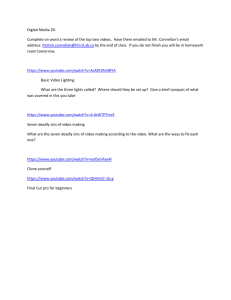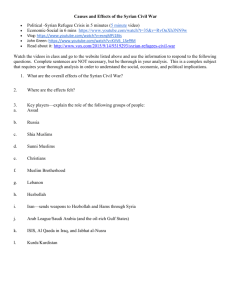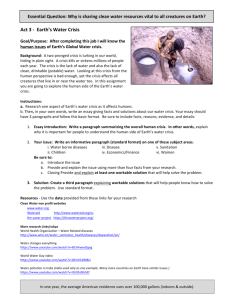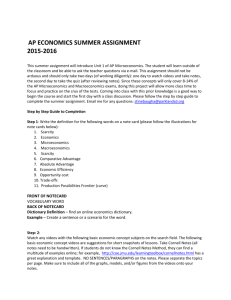What Does the Conductor Do?
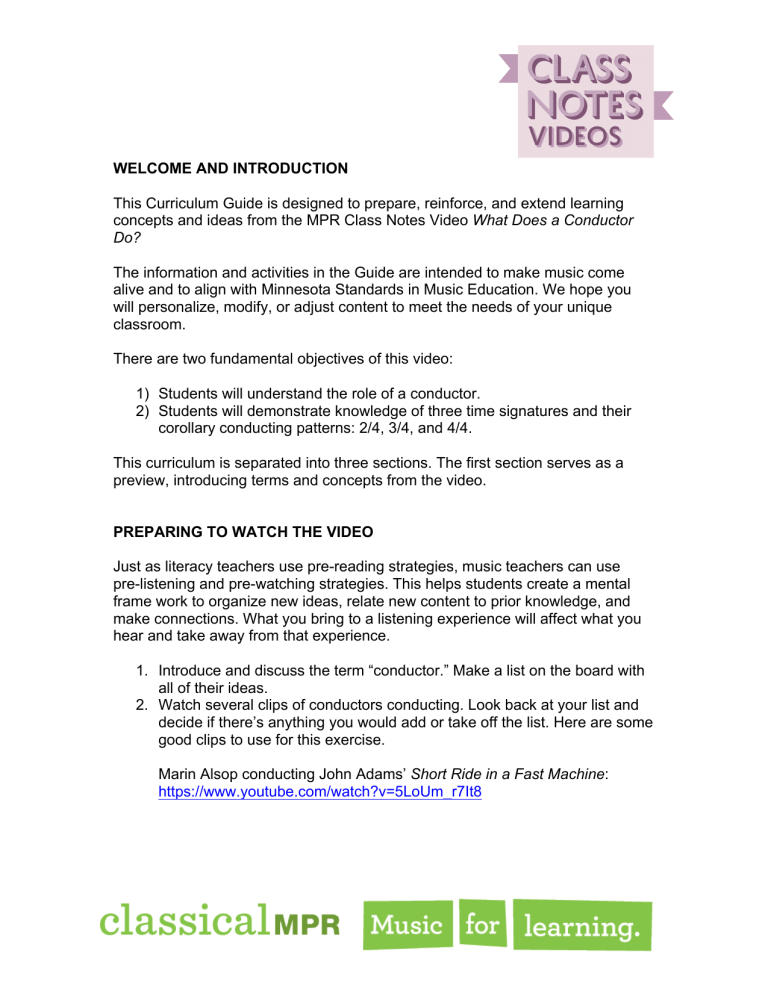
WELCOME AND INTRODUCTION
This Curriculum Guide is designed to prepare, reinforce, and extend learning concepts and ideas from the MPR Class Notes Video What Does a Conductor
Do?
The information and activities in the Guide are intended to make music come alive and to align with Minnesota Standards in Music Education. We hope you will personalize, modify, or adjust content to meet the needs of your unique classroom.
There are two fundamental objectives of this video:
1) Students will understand the role of a conductor.
2) Students will demonstrate knowledge of three time signatures and their corollary conducting patterns: 2/4, 3/4, and 4/4.
This curriculum is separated into three sections. The first section serves as a preview, introducing terms and concepts from the video.
PREPARING TO WATCH THE VIDEO
Just as literacy teachers use pre-reading strategies, music teachers can use pre-listening and pre-watching strategies. This helps students create a mental frame work to organize new ideas, relate new content to prior knowledge, and make connections. What you bring to a listening experience will affect what you hear and take away from that experience.
1. Introduce and discuss the term “conductor.” Make a list on the board with all of their ideas.
2. Watch several clips of conductors conducting. Look back at your list and decide if there’s anything you would add or take off the list. Here are some good clips to use for this exercise.
Marin Alsop conducting John Adams’ Short Ride in a Fast Machine : https://www.youtube.com/watch?v=5LoUm_r7It8
Gustavo Dudamel conducting
Danzón No. 2 by Márquez: https://www.youtube.com/watch?v=P
A7vEIj6Lzk
3. Conductor William Eddins talks a little bit about his experience conducting an orchestra of young musicians. https://www.youtube.com/watch?v=rfpmlizWGbM
4. Here we see Seiji Ozawa, along with some text describing components of conducting technique. https://www.youtube.com/watch?v=iQCG7XH9fkw
5. And one more, of Valery Gergiev, just for comparison. https://www.youtube.com/watch?v=X85KtE7D-Mc
REINFORCE IDEAS AND CONCEPTS FROM THE VIDEO THROUGH ACTIVE
LEARNING
The video What Does a Conductor Do? is great preparation for teaching students basic conducting patterns. Though they may not master conducting technique, learning basic conducting patterns helps students accomplish the following learning objectives: a. Deepens/reinforces understanding of time signatures and meter through kinesthetic learning b. Helps students develop and hone ensemble skills, such as following cues c. Reinforces aspects of musicianship, such as tempo and dynamics, through kinesthetic learning.
Complete this sequence of activities so that students develop an understanding of both time signatures and beat patterns.
1.
Watch Classical MPR’s Class Notes Video: What Does a Conductor Do?
http://www.classicalmpr.org/story/2014/09/19/class-notes-what-does-aconductor-do
2.
Afterward, explain that music is often organized into groups of beats. The time signature tells a musician how the beats are organized and helps them count. If this is a new concept, start easy with 2/4, 3/4, and 4/4. Feel free to substitute a quarter note for the bottom number in a time signature,
at least at first. It’s a good way to reinforce the fact that the quarter note gets a beat. If students have more experience with time signatures, include 6/8, mixed meter, or asymmetrical meters.
3.
Practice a few simple beat patterns. Trace in the air. Count each beat aloud to give kinesthetic reinforcement to the beat placement.
"Conducting-24time" by Hankwang at the English language Wikipedia. Licensed under CC BY-SA
3.0 via Commons - https://commons.wikimedia.org/wiki/File:Conducting-
24time.svg#/media/File:Conducting-24time.svg
"Conducting-34time" by Hankwang at the English language Wikipedia. Licensed under
CC BY-SA 3.0 via Commons - https://commons.wikimedia.org/wiki/File:Conducting-
34time.svg#/media/File:Conducting-34time.svg
"Conducting-44time" by Hankwang at the English language Wikipedia. Licensed under
CC BY-SA 3.0 via Commons - https://commons.wikimedia.org/wiki/File:Conducting-
44time.svg#/media/File:Conducting-44time.svg
4.
Integrate conducting into classroom rehearsal and performance. Ask a student to conduct a favorite classroom song. Give constructive feedback to the conductor. Was the beat pattern clear? Were performers able to follow the conductor?
5.
Look at some examples of printed music and notice the time signatures.
Talk about how you would count the rhythms in each piece you select. If you have a recording of the piece, listen and conduct along, watching the score.
EXTEND LEARNING WITH PROJECTS AND ACTIVITIES
These activities deepen skill development and comprehension.
1. Create a listening sheet. Play various selections and ask students to use their knowledge of conducting patterns to guess the time signature. Below is a blank sample worksheet, followed by a completed sample worksheet.
Feel free to use these or adapt to your own needs.
TITLE
1.
2.
3.
TIME SIGNATURE ADDITIONAL DESCRIPTION
4.
5.
TITLE
Minuet in G
Major
“Trepak” from
COMPOSER TIME
SIGNATURE
J.S. Bach the Nutcracker
Suite
Symphony #7 ,
Op. 92, IV.
P.I.
Tchaikovsky
L.
Beethoven
Maple Leaf Rag S. Joplin
3/4
2/4
2/4
2/4
ADDITIONAL
DESCRIPTION
Oboe plays melody
Fast tempo!
Full orchestra
Piano
“Summertime” from Porgy and
Bess
G. Gershwin 4/4 Orchestral version
*Use the “additional description” box to measure/assess learning in other related areas, i.e. instrumentation, genre classification, etc. In the completed example,
Links for quality YouTube links for the repertoire listed on the listening sheet above:
Bach: https://www.youtube.com/watch?v=on1DDS
LdDOo&list=PLDB6BE778164C9B00
Tchaikovsky: https://www.youtube.com/watch?v=z2ISRM
SIyX8
Joplin: https://www.youtube.com/watch?v=pMAtL7n_-rc
Beethoven: https://www.youtube.com/watch?v=VLkZvsp62iU
Gershiwin: https://www.youtube.com/watch?v=K6DI6ysDemk
STANDARDS
Taken collectively, the content and activities integrate many of the Minnesota
Standard in Music Education. Below is a description of the standard that aligns most closely with these activites.
1. Grades 4-5. 1. Artistic Foundations. 2. Demonstrate knowledge and use of the technical skills of the art form, integrating technology when applicable. Music.
4.1.2.3.1. Read and notate music using standard notation such as quarter, half, and eighth notes and rests, the lines and spaces of the treble clef and time signatures.
